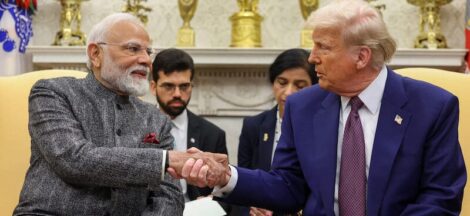What is happening to the “Neighbourhood First” policy of the Indian Prime Minister Narendra Modi in the year 2025? Modi is an expert in coining attractive slogans whether those finally work or not. For South Asia, he opted for Neighbourhood First and for South East Asia and ASEAN nations Act East. At the BIMSTEC summit in Bangkok, Indian Prime Minister talked highly of the possibilities of BIMSTEC by promoting the body as a vital bridge between South and South East Asia. He presented a 21 point action plan for BIMSTEC.
Fine enough. It was encouraging that at a time when the other regional body SAARC is non-functional due India’s non-cooperation and India is not taking enough interests in the functioning of SCO and BRICS, Prime Minister Narendra Modi took active part in the deliberations at the BIMSTEC summit on April 4. His action plan will be considered by the new chairman of BIMSTEC. Bangladesh is taking over as the new chairman of BIMSTEC. Since the national elections in Bangladesh can be held only in the middle of 2026 as per present indications, there is every possibility that the present chief adviser to Bangladesh government Dr. Muhammad Yunus will be presiding over the next BIMSTEC summit in Dhaka.
Indian Prime Minister had his first bilateral meeting with Dr. Yunus at Bangkok on April 4 after the end of BIMSTEC summit. Till the meeting, there was no confirmation from the Indian side, only the Bangladesh officials mentioned that they had got indications that the bilateral meeting would be held in Bangkok. This meeting could have been held with full diplomatic niceties. Then the results could have been a bit better for India. Prime Minister by delaying this meeting with the Bangladesh chief imparted more diplomatic strength to Dr. Yunus to talk to him from a position of strength after getting full backing from the Chinese president Xi Jinping during his visit to Beijing from March 26 to March 29 this year. Dr. Yunus wanted to visit Delhi first as the first of his foreign visit for bilateral talks but South Block did not respond.
Bangladesh is a country of 17 crore population with nearly 8 per cent Hindus. It is true that after the fall of the Sheikh Hasina government and her escape to India, there had been attacks on minorities. The Indian government officials have consistently drawn attention of the Yunus government to the need for proper security measures. In Bangladesh also, the Hindus, Buddhists and Christians have jointly approached the administration for adequate measures. Things are under control now, but the pressure from the Indian side is needed so that the Bangladesh administration keeps vigilant against the acts of the extremists and the religious fundamentalists.
More than eight months have passed since Dr. Yunus took over as the chief adviser to the interim government in Bangladesh, but India has not been able to work out comprehensive programme for maintaining the present state of economic cooperation as also to expand that. The political issues including the demand of extradition of Hasina are long term issues, both the governments know that, but there are some immediate issues which need attention. India can be of help in that. If Prime Minister would have met Dr. Yunus earlier, India could have averted such widespread entry of China in all areas of economic cooperation. More India keeps away from interaction with Bangladesh authorities, more areas will be opened up to China and Pakistan. Further, India’s image, which is already low among the common people of Bangladesh, will go down further.
It is not clear what is India’s plans regarding the future of Sheikh Hasina who is continuously addressing her supporters through video from her place in India. At the Bangkok meeting between Modi and Dr. Yunus, Hasina’s activities formed a major part of talks. Dr. Yunus wanted India to stop Hasina using Indian soil to carry on propaganda against the interim government. Naturally, Modi did not respond to this. Bangladesh chief got enough hint that the extradition issue was nowhere in the agenda of the Indian government for consideration.. On Monday night also, Sheikh Hasina gave a video address assuring the Awami League supporters that she would be back to Bangladesh and deal with all the atrocities committed by the present government on the Awami League members.
Prime Minister Narendra Modi gave one significant assurance to Dr. Yunus that India’s relations are with the Bangladeshi people and the nation, not with any political leader or party. This assurance was needed as India from the earlier Congress days also, is identified with the Awami League and Sheikh Hasina. This impression has to go from the minds of the people of Bangladesh but how to do it when Sheikh Hasina is still in India, that is the big question for the Modi administration.
Right now, Bangladesh is more successful in its diplomacy against India regarding Sheikh Hasina’s extradition. Both in Asia and Europe including European Union, Bangladesh foreign ministry officials have been able to establish that Sheikh Hasina was a tyrant and the upsurge which threw her out was genuine revolt of Bangladesh people against authoritarianism. The UN agencies as also International courts have prepared their reports. The human rights organisations are supporting the present stand of the Bangladesh government against Hasina.
For Narendra Modi, excepting the Trump led U.S., specially the U.S. Intel chief Tulsi Gabbard, no other country is expected to stand by India against Bangladesh on Hasina issue. Even the Trump administration, especially Tulsi Gabbard are now focusing on Bangladesh after the latest China visit of Dr. Yunus and his comments about the North East states as also Indian Ocean territory and how China can be benefitted. The U.S. can not allow China to have any new foothold in Indian Ocean zone through Bangladesh. The U.S. officials are sure to be putting pressure on Dr. Yunus soon..But that has nothing to do with India’s own national interests.
That way, Bangladesh will be the playground of the big powers with China and United States participation. As of now, India has no middle course. It is apparent that India will still stick to the apron strings of Tulsi Gabbard trying to be the sidekick of US in a major geopolitical battle in South Asia. India, population wise the largest country in the world and the most powerful economic power in South Asia has been relegated to the sidelines of geopolitics in Bangladesh. India can only wait and watch. (IPA Service)




 Chinese President Xi Jinping Pledges To Strengthen Ties With Neighbours Amid Trump’s Tariff War With China
Chinese President Xi Jinping Pledges To Strengthen Ties With Neighbours Amid Trump’s Tariff War With China 